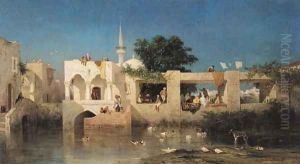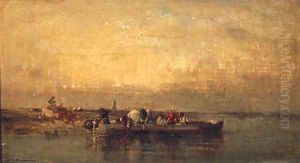Charles de Tournemine Paintings
Charles-Alexandre Coëssin de la Fosse, known as Charles de Tournemine, was a French painter born on August 1, 1812, in Rennes, Brittany. He was noted for his marine paintings and landscapes, often imbued with a romantic sensibility that was characteristic of the mid-19th century. Despite his birth name, he is more commonly referred to as Charles de Tournemine, a name under which he gained considerable recognition in the art world of his time.
Tournemine trained under the tutelage of the French historical painter Paul Delaroche, who was a prominent figure in the Parisian art scene. Under Delaroche’s guidance, Tournemine honed his skills and developed a keen eye for detail, which would later become a defining characteristic of his own work. He exhibited at the Paris Salon, the official art exhibition of the Académie des Beaux-Arts in Paris, and his works were met with acclaim for their technical proficiency and evocative atmosphere.
His artistic career was marked by a fascination with the sea and its ever-changing moods, which he captured with a sense of drama and emotion. Tournemine's seascapes often depicted the Breton coast, where he drew inspiration from the rugged landscape and the tumultuous relationship between the land and sea. He was also inspired by his travels along the Mediterranean coast. The artist's ability to render the power and majesty of the ocean, as well as the tranquility of rural landscapes, resonated with the romantic ideals of the era.
Despite the popularity of his marine scenes, Charles de Tournemine's repertoire was not limited to this genre. He also produced a number of historical and religious works, though these are less well-known today. His versatility as an artist, however, is a testament to his skill and the breadth of his vision.
Charles de Tournemine's paintings are characterized by their luminous quality and the romantic atmosphere that permeates his scenes. His use of light and color to evoke mood and narrative within his works was particularly admired by his contemporaries. Sadly, while his works were popular during his lifetime, Tournemine did not achieve lasting fame, and he is less well-known today than some of his contemporaries.
He passed away on January 21, 1872, in Paris, leaving behind a body of work that, though not widely recognized in the modern era, contributed to the rich tapestry of 19th-century French painting. His works can still be seen in museums and galleries, particularly in France, where they continue to be appreciated by those who seek to understand the romantic currents that influenced art of that period.



